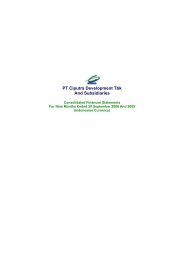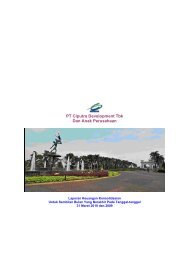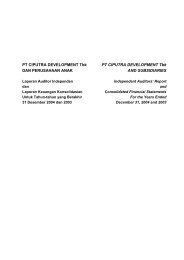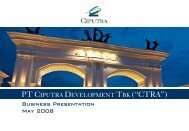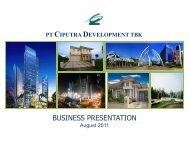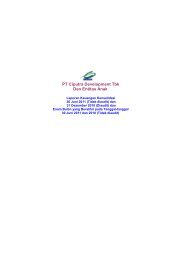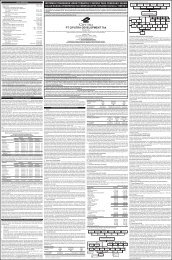2009 - Ciputra Development
2009 - Ciputra Development
2009 - Ciputra Development
Create successful ePaper yourself
Turn your PDF publications into a flip-book with our unique Google optimized e-Paper software.
The original consolidated financial statements included herein are in<br />
the Indonesian language<br />
PT CIPUTRA DEVELOPMENT Tbk<br />
DAN ANAK PERUSAHAAN<br />
CATATAN ATAS LAPORAN KEUANGAN<br />
KONSOLIDASI<br />
Tahun yang Berakhir pada Tanggal-tanggal<br />
31 Desember 2010 dan <strong>2009</strong><br />
(Disajikan dalam rupiah, kecuali dinyatakan lain)<br />
PT CIPUTRA DEVELOPMENT Tbk<br />
AND SUBSIDIARIES<br />
NOTES TO THE CONSOLIDATED<br />
FINANCIAL STATEMENTS<br />
Years Ended<br />
December 31, 2010 and <strong>2009</strong><br />
(Expressed in rupiah, unless otherwise stated)<br />
33. REVISI PERNYATAAN STANDAR AKUNTANSI<br />
KEUANGAN (lanjutan)<br />
f. PSAK No. 7 (Revisi 2010), “Pengungkapan<br />
Pihak-pihak Berelasi”, mensyaratkan<br />
pengungkapan hubungan, transaksi dan saldo<br />
pihak-pihak yang berelasi, termasuk komitmen,<br />
dalam laporan keuangan konsolidasi dan<br />
laporan keuangan tersendiri entitas induk, dan<br />
juga diterapkan terhadap laporan keuangan<br />
secara individual.<br />
g. PSAK No. 8 (Revisi 2010), “Peristiwa Setelah<br />
Periode Pelaporan”, menentukan saat suatu<br />
perusahaan harus menyesuaikan laporan<br />
keuangannya untuk peristiwa setelah tanggal<br />
neraca dan pengungkapan yang harus dibuat<br />
tentang tanggal penerbitan laporan keuangan<br />
dan tentang peristiwa setelah tanggal neraca.<br />
Pernyataan ini juga menentukan bahwa suatu<br />
perusahaan tidak boleh menyusun laporan<br />
keuangannya atas dasar kelangsungan usaha<br />
bila peristiwa setelah tanggal neraca<br />
mengindikasikan bahwa penerapan asumsi<br />
kelangsungan usaha tidak tepat.<br />
h. PSAK No. 12 (Revisi <strong>2009</strong>), “Bagian<br />
Partisipasi dalam Ventura Bersama”, akan<br />
diterapkan untuk akuntansi bagian partisipasi<br />
dalam ventura bersama dan pelaporan aset,<br />
kewajiban, penghasilan dan beban ventura<br />
bersama dalam laporan keuangan venturer<br />
dan investor, terlepas dari struktur atau bentuk<br />
yang mendasari dilakukannya aktivitas ventura<br />
bersama.<br />
i. PSAK No. 15 (Revisi <strong>2009</strong>), “Investasi Pada<br />
Entitas Asosiasi”, akan diterapkan untuk<br />
akuntansi investasi dalam entitas asosiasi.<br />
j. PSAK No. 19 (Revisi 2010), “Aset tak<br />
Berwujud”, menentukan perlakuan akuntansi<br />
bagi aset tak berwujud yang tidak diatur secara<br />
khusus dalam PSAK lain. Pernyataan ini<br />
mensyaratkan untuk mengakui aset tak<br />
berwujud jika, dan hanya jika, kriteria tertentu<br />
dipenuhi, dan juga mengatur cara mengukur<br />
jumlah tercatat dari aset tak berwujud dan<br />
menentukan pengungkapan yang diisyaratkan<br />
tentang aset tak berwujud.<br />
k. PSAK No. 22 (Revisi 2010), “Kombinasi<br />
Bisnis”, diterapkan untuk transaksi atau<br />
peristiwa lain yang memenuhi definisi<br />
kombinasi bisnis guna meningkatkan relevansi,<br />
keandalan, dan daya banding informasi yang<br />
disampaikan entitas pelapor dalam laporan<br />
keuangannya tentang kombinasi bisnis dan<br />
dampaknya.<br />
33. RECENT DEVELOPMENTS AFFECTING<br />
ACCOUNTING STANDARDS (continued)<br />
f. PSAK No. 7 (Revised 2010), “Related Party<br />
Disclosures”, requires disclosure of related<br />
party relationships, transactions and<br />
outstanding balances including commitments,<br />
in the consolidated and separate financial<br />
statements of a parent, and also applies to<br />
individual financial statements.<br />
g. PSAK No. 8 (Revised 2010), “Events after the<br />
Reporting Period”, prescribes when an entity<br />
should adjust its financial statements for<br />
events after the reporting year and the<br />
disclosures that an entity should give about<br />
the date when the financial statements are<br />
authorized for issue and about events after the<br />
reporting year. The Standard also requires<br />
that an entity should not prepare its financial<br />
statements on a going concern basis if events<br />
after the reporting year indicate that the going<br />
concern assumption is not appropriate.<br />
h. PSAK No. 12 (Revised <strong>2009</strong>), “Interests in<br />
Joint Ventures”, provides guidance to be<br />
applied in accounting for interests in joint<br />
ventures and the reporting of joint venture<br />
assets, liabilities, income and expenses in the<br />
financial statements of venturers and<br />
investors, regardless of the structures or forms<br />
under which the joint venture activities take<br />
place.<br />
i. PSAK No. 15 (Revised <strong>2009</strong>), “Investments in<br />
Associates”, provides guidance to be applied<br />
in accounting for investments in associates.<br />
j. PSAK No. 19 (Revised 2010), “Intangible<br />
Assets”, prescribes the accounting treatment<br />
for intangible assets that are not dealt with<br />
specifically in another PSAK. It requires the<br />
recognition of an intangible asset if, and only<br />
if, the specified criteria are met, and also<br />
specifies how to measure the carrying amount<br />
of intangible assets and related disclosures.<br />
k. PSAK No. 22 (Revised 2010), “Business<br />
Combinations”, applies to a transaction or<br />
other event that meets the definition of a<br />
business combination to improve the<br />
relevance, reliability and comparability of the<br />
information that a reporting entity provides in<br />
its financial statements about a business<br />
combination and its effects.<br />
101



